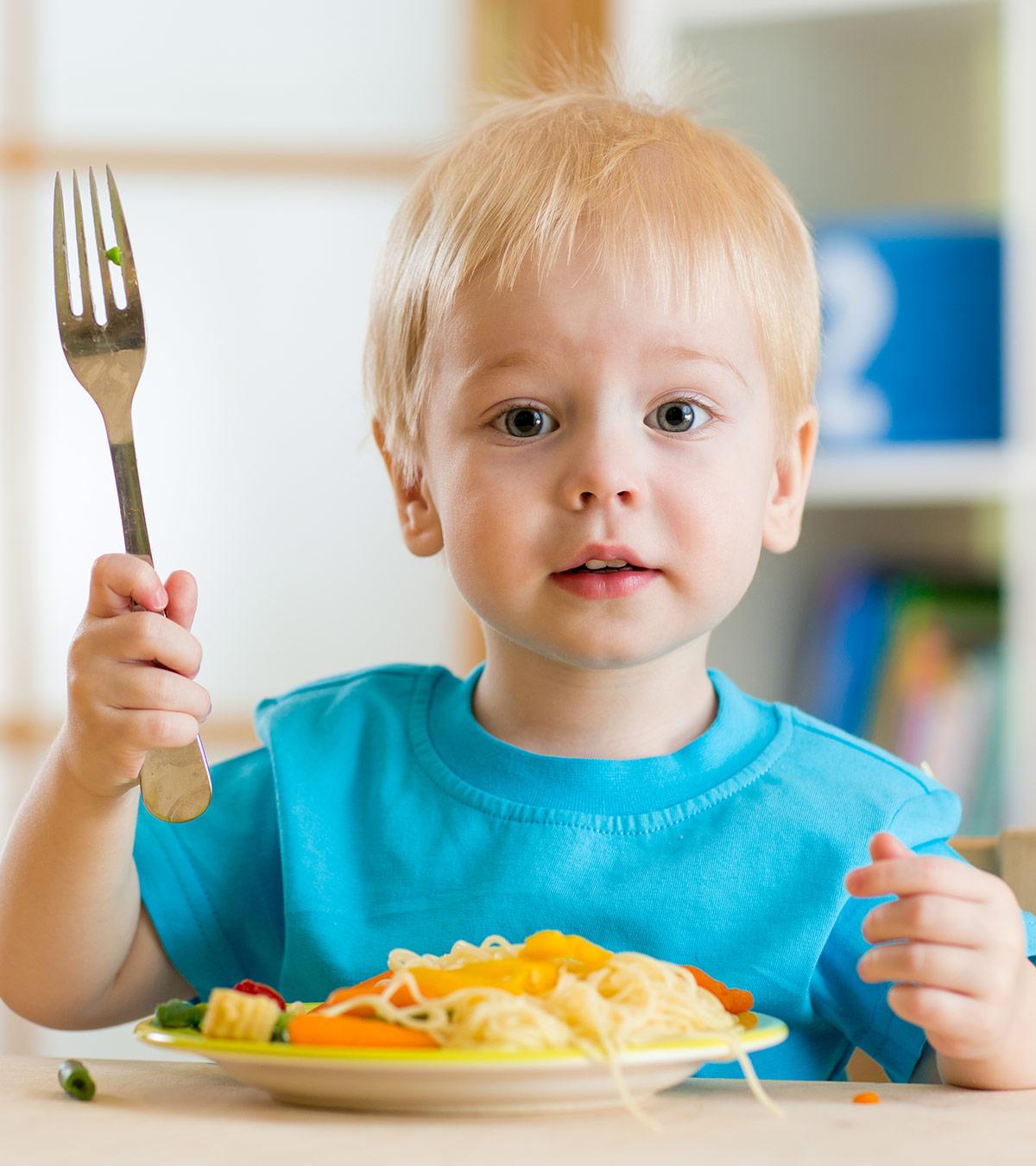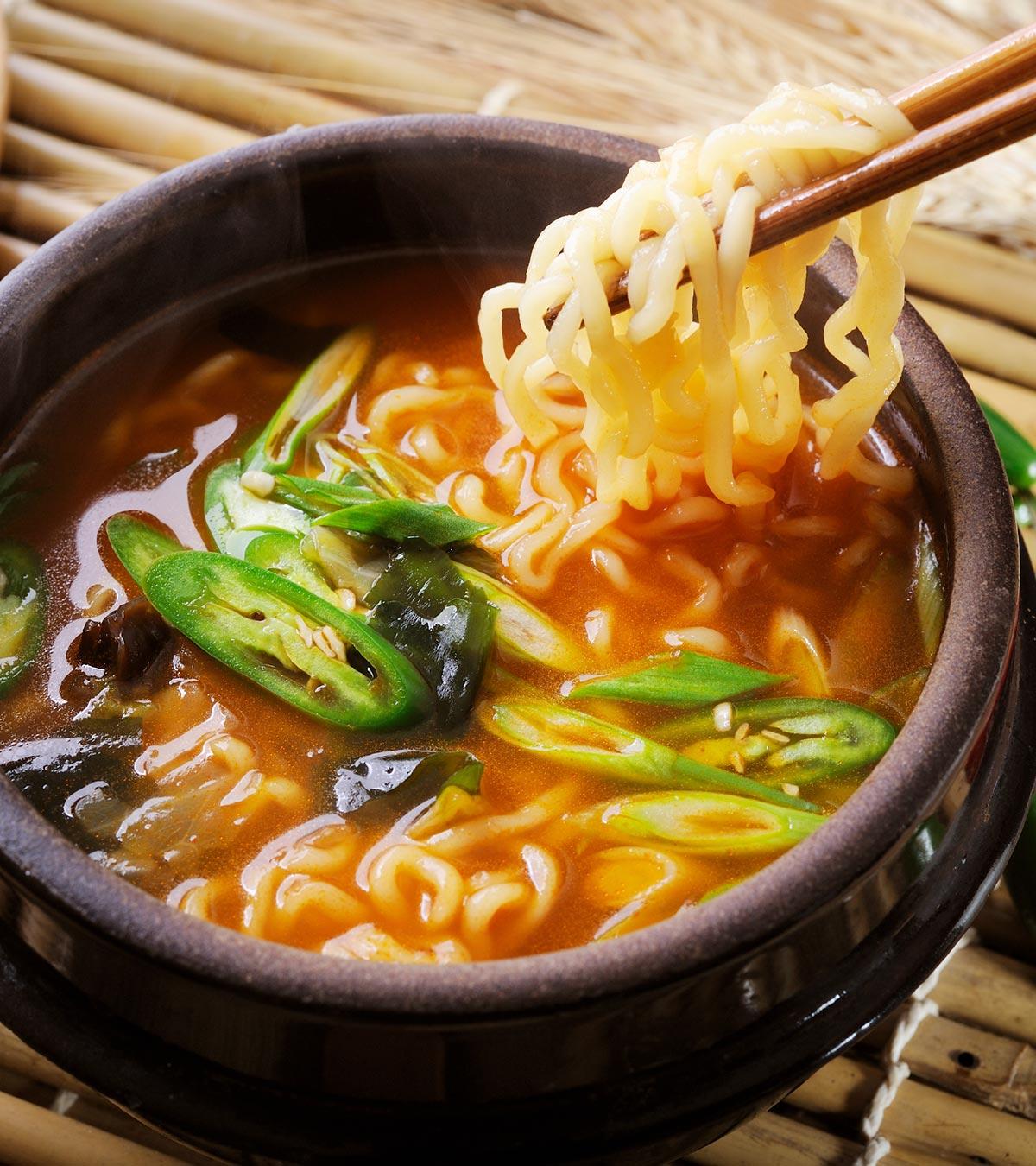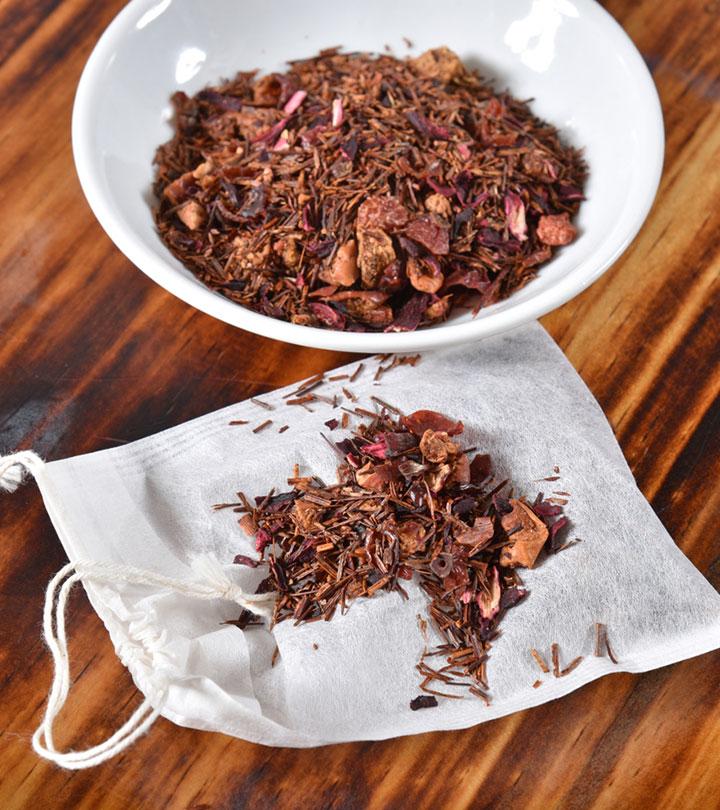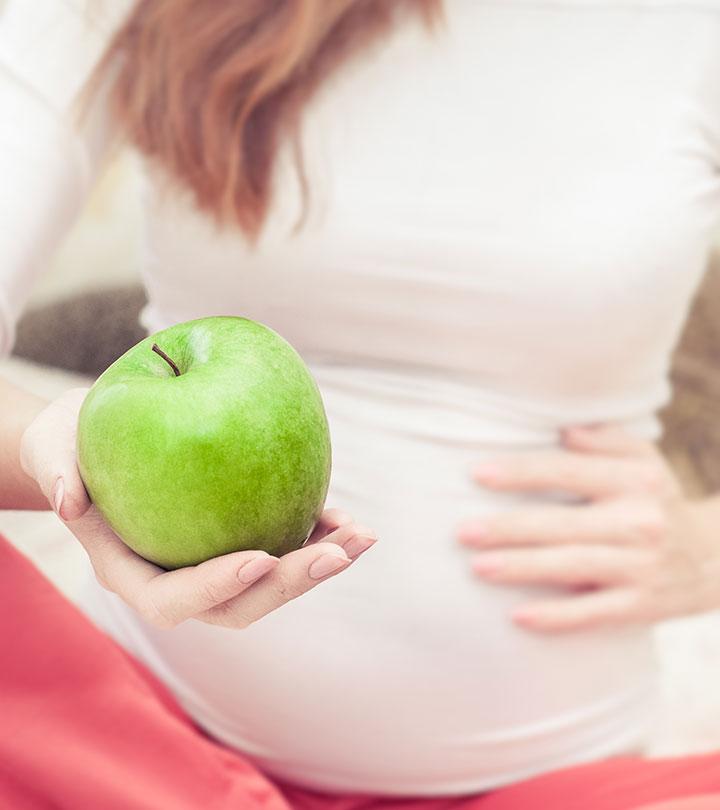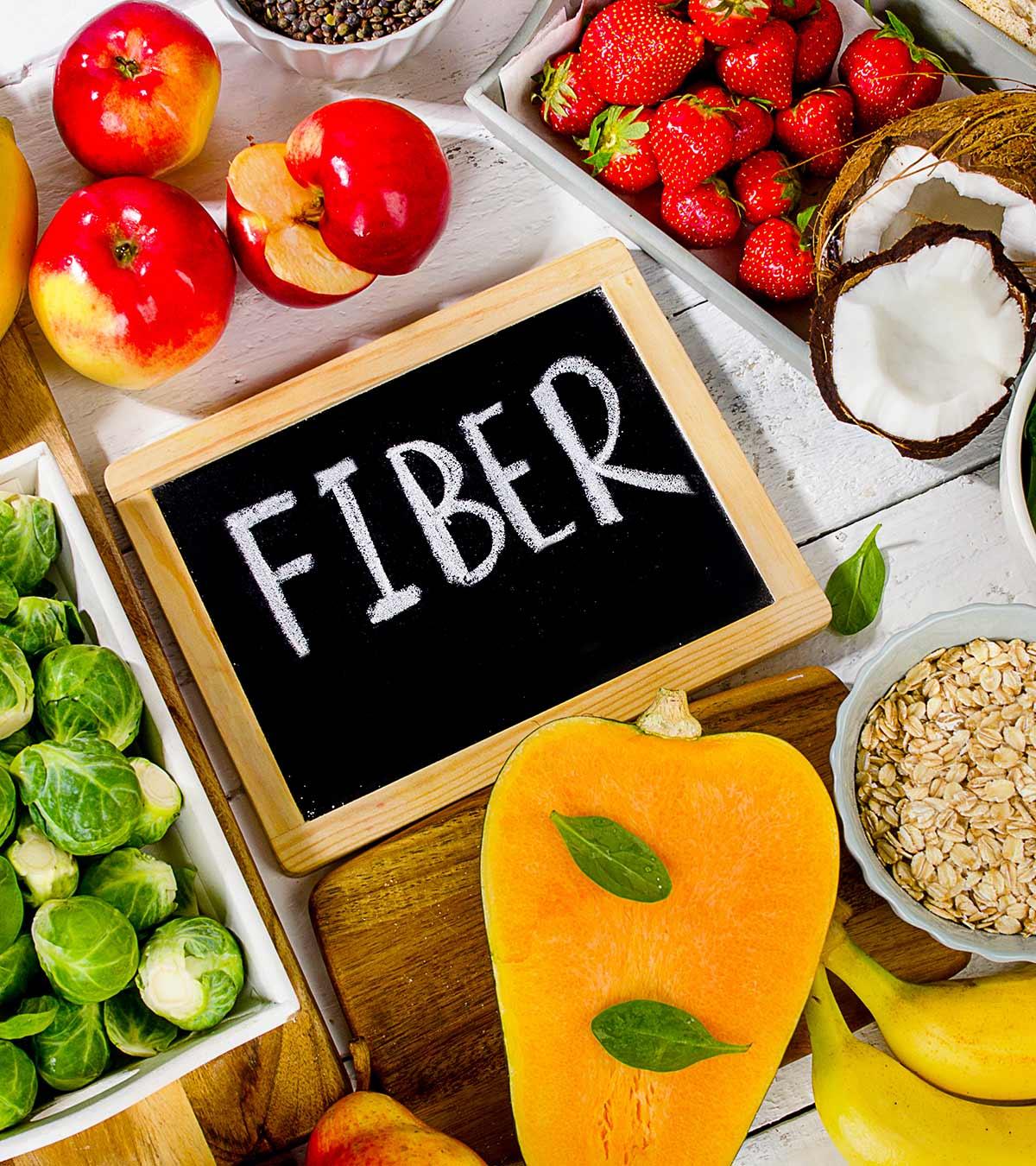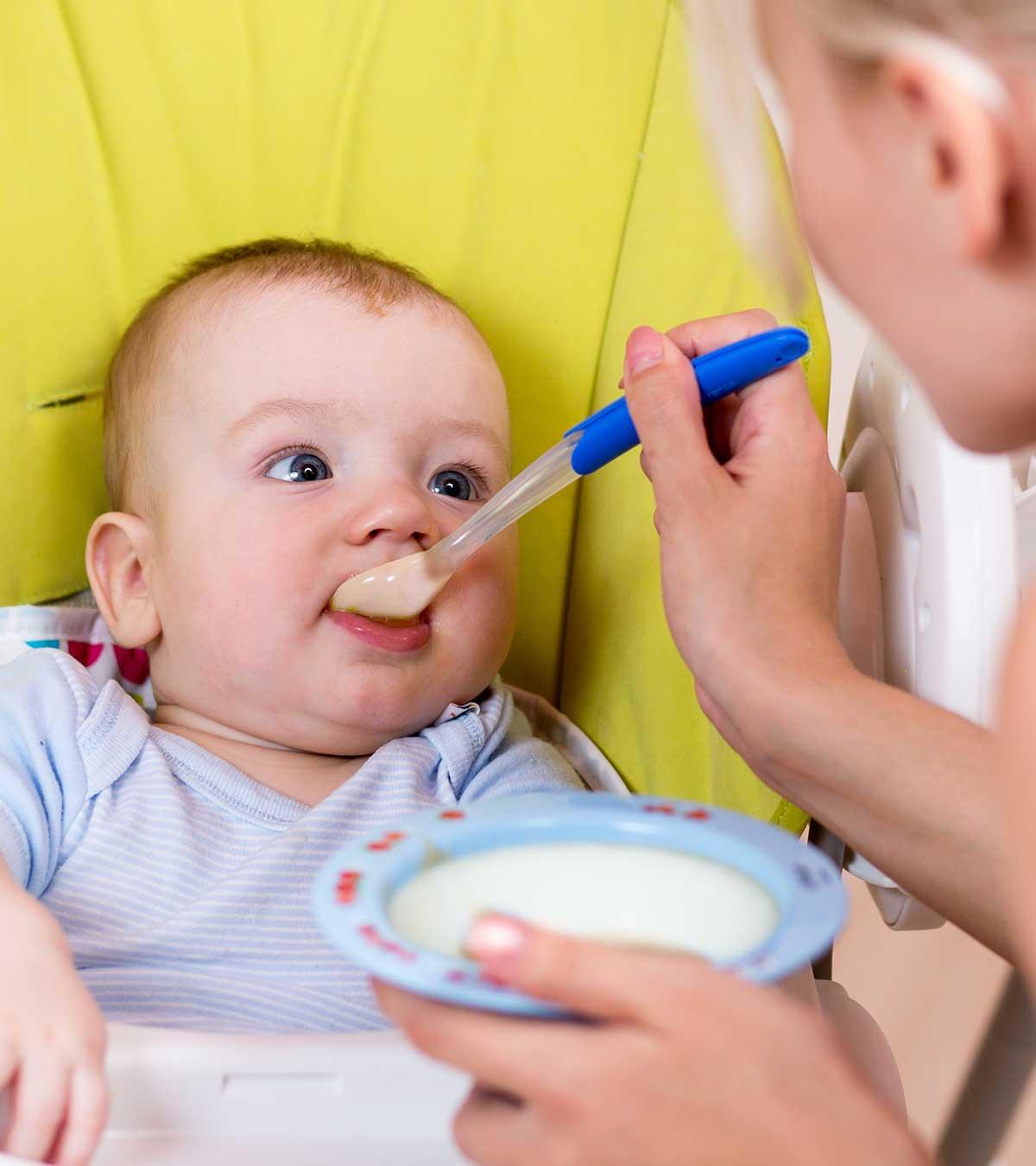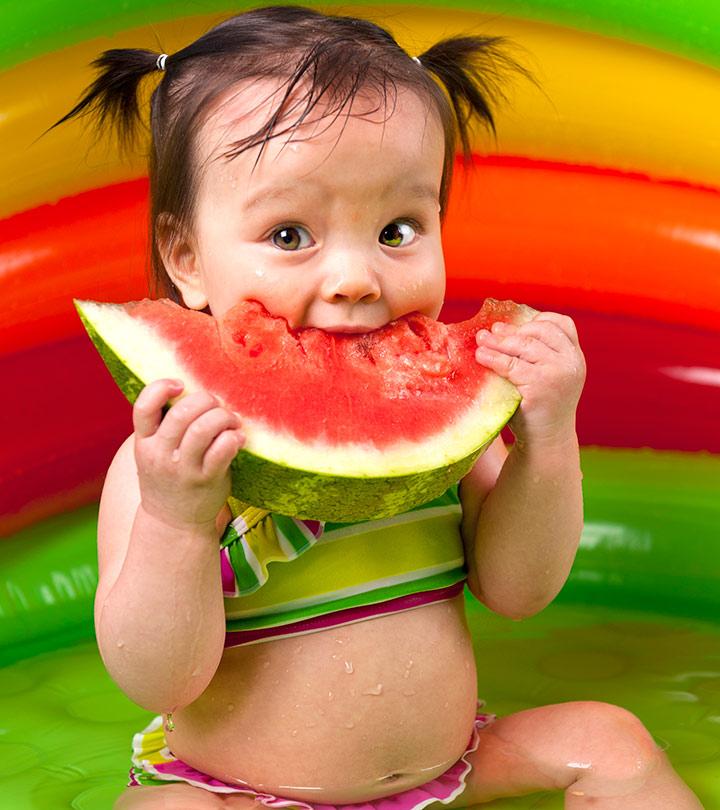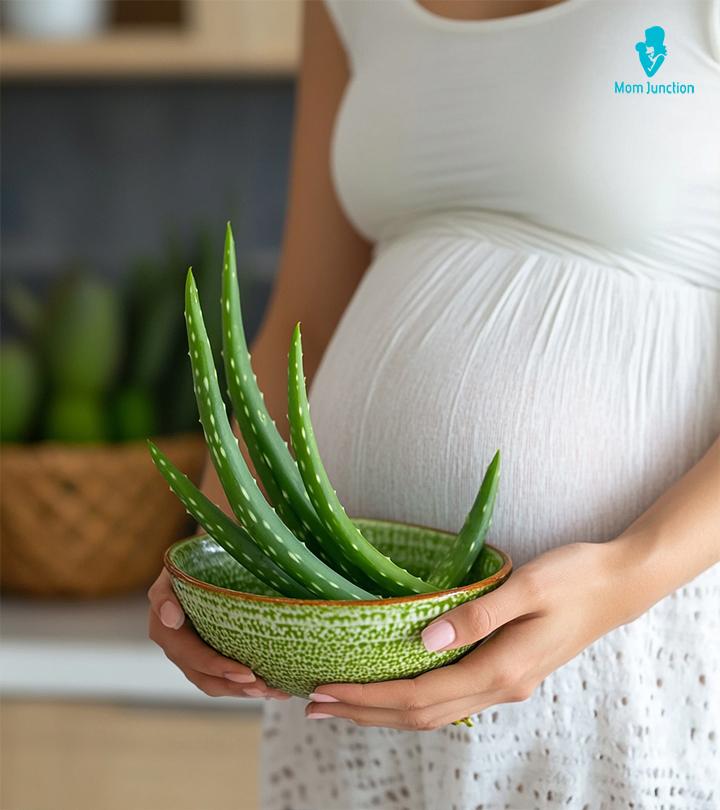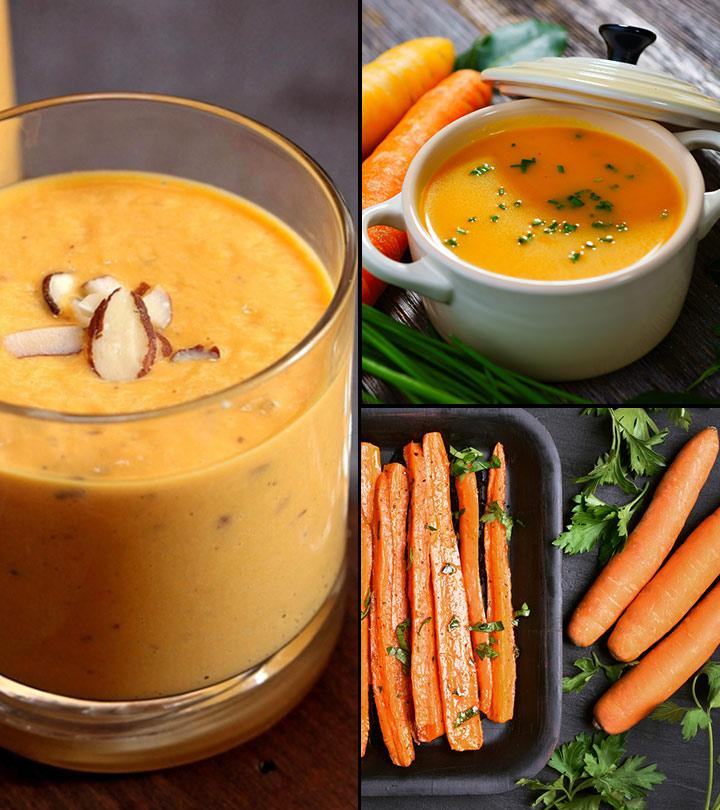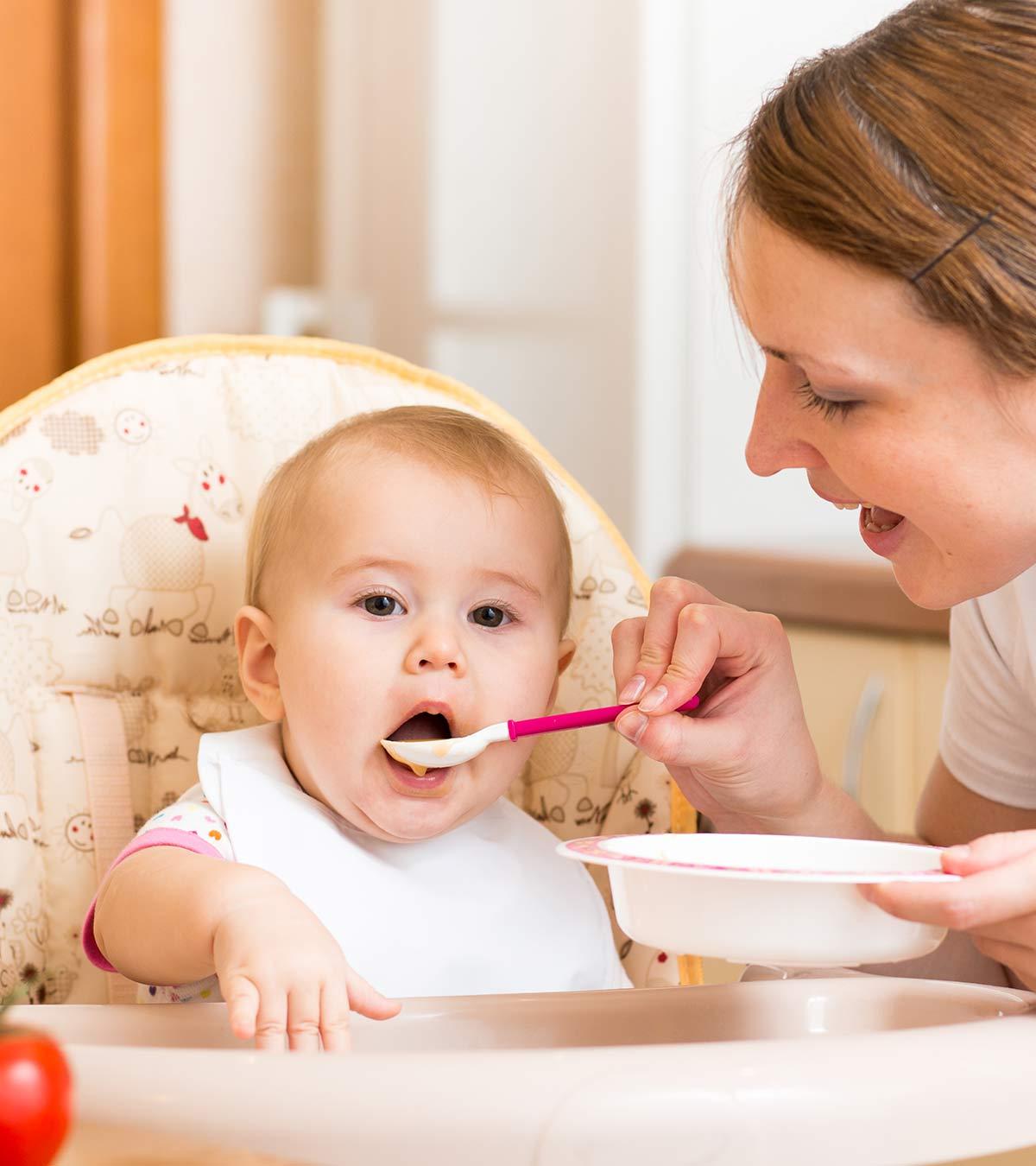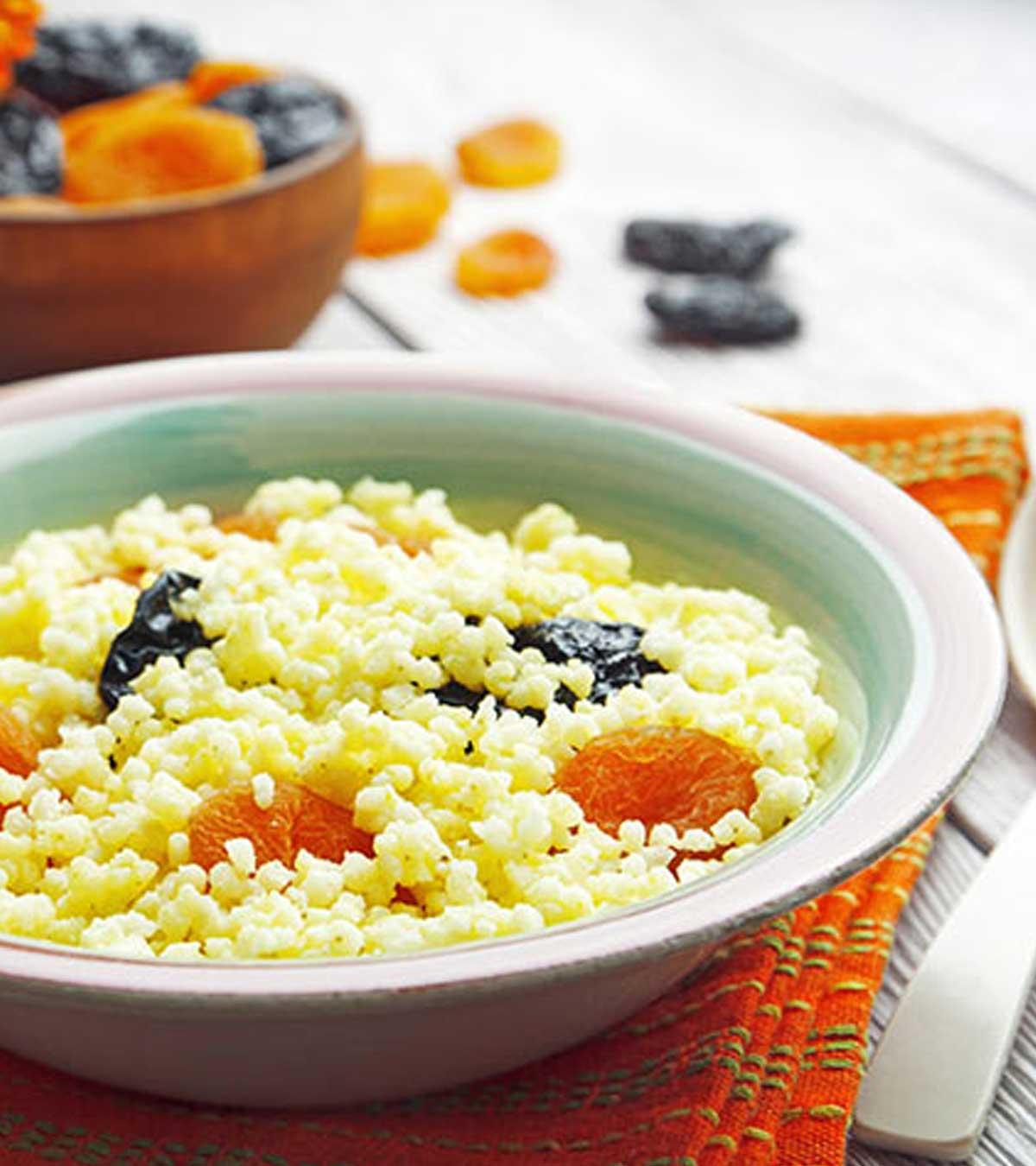
Image: Shutterstock
Pasta is a high-carbohydrate Italian classic dish that includes noodles, lasagna, macaroni, and more. Pasta comes in a variety of shapes and sizes. Parents may consider pasta for babies since it is regarded as safe when consumed in an age-appropriate way, although it may not be particularly nutritious. Knowing the right time and way to introduce pasta to your baby is essential for their health and nutrition.
Read on to learn about the various types of pasta, their safety for babies, their nutritional value, and how to incorporate them into your baby’s diet.
Key Pointers
- Babies six months and above, eating various solid foods, can consume well-cooked pasta.
- Prepare different pasta dishes to introduce your baby to various flavors. Pick pasta made of healthy items like whole wheat or pulses. Add more ingredients, such as fresh, seasonal veggies, cheese, and dried herbs, while preparing to make the dish attractive, tasty, and nutritious.
- Cut pasta into small pieces before serving it to the baby to mitigate the choking risk.
Is Pasta Safe For Babies?
You can safely feed pasta to your baby once they have started consuming a variety of foods. Traditionally, pasta is made from durum wheat, but it is also made from wheat, rice, barley, buckwheat, legumes, and multigrain. Therefore, you need to know the base ingredient while choosing pasta.
- Wheat pasta is safe for babies who have been consuming wheat in their diet. However, it is good to be alert to any signs of gluten intolerance or wheat allergy while introducing pasta to babies. Symptoms of an allergic reaction include bloating, vomiting, rash, and diarrhea. Those who have wheat allergy and/or gluten intolerance should not eat pasta or introduce it much later after consulting with your baby’s pediatrician
- If you want to try other varieties of pasta for your baby, then first consult a pediatrician.
- Introduce no more than a quarter to half a cup of pasta to your infant in mashed form. You can feed small pieces of cooked pasta as finger food once your baby turns nine months old.
- Boil and cook pasta adequately since it is dry food and could be difficult to swallow even for older babies.
 Point to consider
Point to considerWhen And How To Introduce Pasta To Infants?
, a practicing pediatrician from Fort Worth, Texas, says, “For babies, cook pasta to a soft consistency. When using boiled pasta, look at the package directions and cook the pasta to the maximum amount of time required. For example, spaghetti is cooked for 10 to 13 minutes. Cooking for ten minutes is considered al dente, which means a firm consistency. Soft is the best until your baby is eating pasta effectively.”
Babies above six months can consume pasta in various ways. Ensure you serve only cooked, soft, easy-to-swallow pasta cut into small pieces (1). According to the American Academy of Pediatrics (AAP), food accounts for over fifty percent of all choking incidences. Therefore, babies should be served food in age-appropriate ways. Some pasta varieties can be large and broad in shape, so cut them into small, manageable pieces to prevent choking.
Mix pasta with a variety of other foods, such as vegetables, such as broccoli, cauliflower, carrots, green beans, chicken, eggs, and tofu, to make a nutritious and flavorful meal. You can also make it more enjoyable by choosing various shapes, such as stars, mini shells, bows, and pasta of different colors. These shapes are easier for little hands to grasp and can encourage self-feeding.
Nutritional Value Of Pasta
Regular pasta is either prepared from refined wheat flour or whole grain wheat flour mixed with eggs and water. Pasta made from refined flour might be enriched with nutrients, such as iron and vitamins B1, B2, B3, and folate (2).
Below is a comparative nutritional composition analysis of 100g of pasta made from wholewheat flour cooked with added salt and enriched pasta cooked with added salt (3) (4) (5) (6).
| Nutrients | Whole wheat pasta | Enriched wheat pasta | RDA (7-12 months) |
|---|---|---|---|
| Energy(Kcal) | 148 | 157 | – |
| Protein(g) | 5.95 | 5.8 | – |
| Carbohydrate, by difference(g) | 29.9 | 30.6 | – |
| Fiber, total dietary(g) | 3.9 | 1.8 | – |
| Calcium, Ca(mg) | 13 | 7 | 270 |
| Iron, Fe(mg) | 1.71 | 1.28 | 10 |
| Magnesium, Mg (mg) | 54 | 18 | 60 |
| Phosphorus, P (mg) | 126 | 58 | 275 |
| Potassium, K (mg) | 95 | 44 | 700 |
| Sodium, Na (mg) | 235 | 131 | 200 |
| Thiamin (mg) | 0.155 | 0.274 | 0.4 |
| Riboflavin (mg) | 0.098 | 0.136 | 0.5 |
| Niacin (mg) | 3.11 | 1.69 | 6 |
| Vitamin B6 (mg) | 0.092 | 0.049 | 0.6 |
| Folate, total (µg) | 21 | 73 | 35 |
Sources: U.S. Department of Agriculture, World Health Organization, and National Institutes of Health
Are There Any Benefits Of Pasta For Babies?
Pasta does not hold any specific health benefits per se. But here is why parents might feed pasta to their babies:
- Easy to consume: Well-cooked pasta is soft and can be mashed easily. It makes pasta chewable and easy-to-swallow food. It can also be given as finger food for toddlers. Moreover, babies might enjoy the taste, just like their parents do.
According to a mother of one, “Pasta spirals are great – easier for little hands to hold than penne or spaghetti. I find this is a good ‘leftover for baby’ meal – make it for mum and dad the night before and the baby can have it the next day. The grated cheese will help the pasta stick together when it’s cooled, making it easier for the baby to grab handfuls (i).”
- Rich in energy: Babies above six months of age require energy-dense foods to support their rapid growth and development (7). However, do not overfeed the baby with pasta.
Dr. Lewis adds, “Pasta is a grain, which is a nutritional staple, but it’s important to ensure your baby is eating all food groups. Pasta can be blended for babies but will be sticky if prepared alone. Add a fresh vegetable or other palatable ingredients with pasta to prepare a puree.”
Whole grain pasta can provide fiber and protein. Do not use pasta as a replacement for more nutritious foods such as whole wheat, rice, pulses, etc.
Precautions To Take While Feeding Pasta To Infants
You may follow these precautions while feeding pasta to babies.
- Feed pasta in moderation and as part of a balanced diet.
- Check the base ingredient of the pasta before purchase. For babies who have just started solids, rice flour pasta, durum wheat, and common wheat flour pasta are some good choices. For toddlers, you can try to add variety by trying pasta made from buckwheat, quinoa and pulses.
- If you are worried about the presence of egg in pasta, then choose varieties that do not contain egg.
- Chosoe whole-grain pasta instead of refined and enriched pasta. Enriched pasta is made from refined flour, which loses nutrients and fiber while refining. It is not readily processed by the body.
- Try to prepare fresh, homemade pasta instead of picking ready-to-serve varieties. Preparing pasta at home can let you have more control over the ingredients. Make sure to refrigerate and freeze it if not consuming right away.
- If you are introducing wheat to your baby in the form of pasta, then it is recommended to follow a “three to five-day wait” rule to watch-out the sensitivities or allergies.
- When giving pasta as finger food, be watchful to prevent choking. Give them small-sized pasta or cut regular-sized pasta into smaller pieces.
- If your baby does not seem to like the texture of pasta, then you can stop feeding it for a few days.
 Quick tip
Quick tipHealthy Pasta Baby Food Recipes
Pasta can be made healthy and nutritious in a variety of ways. All you need to do is select the right ingredients and be creative. Below are some healthy and tasty pasta recipes that can be given to babies and toddlers. Recipes with whole milk can be fed to toddlers older than 12 months.
1. Pumpkin pasta puree
Image: Shutterstock
Pumpkin is a nutritious vegetable. This recipe allows you to combine the goodness of pumpkin with the delicious taste of pasta.
You will need:
- ½ cup rice pasta or any organic pasta (cooked)
- 1 cup pumpkin (cooked)
- 5 cup milk
- 100g sweet potato
- 40g sweetcorn
- 3tbsp mozzarella cheese (grated)
- 1tbsp extra virgin olive oil
How to:
- Boil milk and sweet potato in a saucepan on medium flame. Reduce the flame and simmer the mixture for ten minutes.
- Add the sweetcorn and cook for ten minutes.
- Switch off the flame, transfer the mixture into a bowl, and let it cool.
- Now, add cheese and pasta to the mix and blend it into a coarse puree.
- Put a saucepan on medium flame and add olive oil. Transfer the blended mixture to the pan and cook for two to three minutes.
- Switch off the flame and transfer the pasta puree into a serving bowl. Feed to your baby while still warm.
Tip: You can use any other vegetable or fruit puree to customize this recipe. As your baby adjusts to the taste, use multigrain pasta to enhance its overall nutritional value.
2. Pasta with cheesy sauce
Image: Shutterstock
A delicious blend of pasta with whole milk and cheddar cheese, this recipe is ideal for babies who have started consuming solids and are trying pasta for the first time. Adding this dish to your baby’s diet is a great way to introduce them to Italian cuisine and expand their palate.
You will need:
- ½ cup mini shell or orzo pasta (cooked)
- 1 cup whole milk
- 100g cheddar cheese
- ¼ cup butter
How to:
- Take a thick bottom pan and put it on medium flame.
- Once the pan is warm, put butter in it and let it melt.
- Add milk while stirring constantly. Let the mixture simmer for 10-12 minutes or until you see milk getting a little thick.
- Switch off the flame and add cheese to the mix. Stir until you get a smooth sauce.
- Add cooked pasta to the sauce and mash it.
- Feed it to your baby when it is still warm.
Tip: You can improve the nutritional value and color of this preparation by adding vegetable puree, mash, or tiny pieces.
3. Tangy tomato pasta
Image: Shutterstock
This vegetable pasta recipe might become your baby’s favorite pasta if they like the tangy taste of tomatoes.
You will need:
- ½ cup wholewheat pasta (cooked)
- 70g ripe tomatoes (blanched)
- 1 onion (finely chopped)
- 1 clove of garlic (crushed)
- 2tbsp mozzarella cheese (grated)
- 2tbsp virgin olive oil
How to:
- Put a saucepan on medium flame and let it get warm.
- Drizzle some drops of olive oil and add onions and garlic.
- Fry onions and garlic until they turn golden brown.
- Next, add blanched tomatoes and break them with the help of a spoon. Let the mixture cook for ten minutes.
- Switch off the flame once the tomatoes look mushy and well-cooked, and let the mixture cool.
- Blend the cooked tomatoes and onions into sauce with an immersion blender.
- Transfer the sauce into the same saucepan and put the pan on low heat. Add pasta of your choice with some drizzles of olive oil and grated cheese. Cut the pasta into small pieces or mash it.
- Cook for two to three minutes and switch off the flame.
- Serve when still warm.
Tip: You can add grated veggies, tofu, or chicken into the recipe to intensify its nutritional value.
4. Pasta soup
Image: Shutterstock
This recipe is a creative mix of pasta and soup to help your baby get the best of ingredients in an easy-to-consume and easy-to-digest way.
You will need:
- 70g Anelli pasta (cooked)
- 50g cottage cheese (blended)
- 70g red lentil
- 300ml chicken or vegetable stock (low salt)
- 300ml water
- 70g carrot (sliced)
- 1 onion (chopped)
- 1-2 cloves garlic (crushed)
- 1tbsp virgin olive oil
- 1tbsp chive (chopped)
How to:
- Keep a large pan on medium flame and pour olive oil into it.
- Put onion, garlic, and carrot to the pan and cook until all the ingredients look soft and well-cooked.
- Add the lentils, lentil stock, and water. Bring this mixture to a boil and let it simmer for 15-20 minutes.
- Switch off the flame, remove the pan from the heat, and let the mixture cool for five minutes.
- Use an immersion blender to blend the ingredients into a soup-like consistency. You can add more stock/water to adjust the texture of the soup if needed.
- Put the pan back on the flame, add cooked pasta and blended soup, and cook the dish for five minutes.
- Turn off the heat, add blended cottage cheese, and serve while still warm
Tip: You can try adding seasonal veggies like spinach, broccoli, corn, peas, and bell peppers, too.
5. Veggie burst Bolognese pasta
Image: Shutterstock
Bolognese pasta is prepared by cooking pasta in a meat-based sauce. But this veggie pasta recipe is a delicious vegetarian alternative to Bolognese pasta inspired by Mediterranean cuisine.
You will need:
- 1 cup acini de pepe (cooked)
- 1 26 oz. tomato puree
- 1 onion (roughly chopped)
- 1 garlic cloves (crushed)
- 1 carrots (chopped)
- 1 rib celery (chopped)
- ½ cup corn (boiled)
- ½ cup bell pepper (chopped)
- ½ cup fresh parsley (chopped)
- 1tbsp extra-virgin olive oil
How to:
- Put onion, carrot, corn, bell peppers, and celery into a food processor and shred them. Keep aside for some time.
- Next, keep a shallow pan on medium flame and pour oil into it.
- As the oil heats, transfer the vegetables into the pan and cook until the vegetables turn soft.
- Now, add tomato puree to the vegetables and bring the mixture to the boil. Cover the lid and let the mixture simmer for ten minutes.
- Remove the lid and let the mixture cook on low flame until you get the desired thickness.
- Once the sauce looks ready, switch off the flame and let the mixture cool.
- Using an immersion blender, blend the mixture into a sauce.
- Add pasta into the sauce and cook the mixture for five minutes on low flame, again.
- Add parsley and serve while still warm.
Tip: Alternatively, you can prepare this recipe by adding meat, chicken, and eggs into the sauce or the final pasta dish.
6. Cheesy zucchini pasta
Image: Shutterstock
Zucchini is a healthy food that contains beta-carotene.
You will need:
- 1 cup zucchini/courgette (grated)
- 2 cups water
- 1 cup penne pasta or tortellini or any small-shaped pasta (cooked)
- 1 egg yolk
- 1tbsp parmesan (grated)
- 1tbsp extra virgin olive oil
- 1/4tsp herb mix
How to:
- Take a saucepan and put it on low flame. Add zucchini and water into it and cook for five minutes.
- Now, add pasta, egg yolk, cheese, and olive oil into the zucchini. Let the mixture simmer for five to seven minutes or until pasta absorbs most of the water and looks thickly covered in sauce to give that thick and cheesy consistency.
- Add more water if you want the pasta sauce to be thin.
- Turn off the heat and transfer the pasta into a serving bowl and serve.
Tip: Alternatively, you can prepare this recipe by adding meat, chicken, and eggs into the sauce or the final pasta dish.
7. Pea and pesto sauce gnocchi
Image: Shutterstock
Gnocchi is a type of pasta that looks like small shells. It is most suitable for infants honing their weaning skills.
You will need:
- 1 cup gnocchi (cooked)
- 30g peas (fresh/frozen)
- 1 onion (finely chopped)
- 20g parmesan cheese (grated)
- Handful of basil leaves (chopped)
- 4tbsp virgin olive oil
- ¼tsp herb mix
How to:
- Blend peas, cheese, basil, and olive oil into a smooth sauce. Ensure that there are no lumps. Adjust the consistency by adding water if needed.
- Pour the pasta sauce into a saucepan, drizzle a few drops of olive oil, add herb mix, and gnocchi. Cook for five minutes on low flame.
- Transfer to a serving bowl and serve immediately.
Tip: Gnocchi, like any other type of pasta variety, can be prepared in several ways. You can add different vegetables or try different sauces to customize this classic recipe for your infant.
Frequently Asked Questions
1. What kind of pasta is best for babies?
Well-cooked, small, and spiral pasta made of wheat is best for babies since babies can eat it easily (8). Further, you can chop or mash pasta into small pieces.
2. Can babies eat macaroni?
Any type of pasta, including macaroni, can be included in your baby’s diet once they start eating solid meals (1).
3. Do babies need special pasta?
Babies do not need special pasta. Regular pasta can be used for babies, but it is important to ensure it is cooked until it is soft and easy to chew or mash with gums. For added nutritional value, you can try pasta made from whole grains or legumes.
4. Can babies eat pasta with no teeth?
It is recommended to cook the pasta until it is soft and easily mashed with gums or cut it into small, bite-sized pieces to make it safe for babies without teeth to consume.
5. Is it okay for babies to eat pasta every day?
While pasta can be a part of a balanced diet for babies, giving them pasta daily may not be ideal. It is important to offer a variety of foods to ensure they receive a wide range of nutrients from different sources.
6. Is pasta hard for babies to digest?
Pasta is generally easy for babies to digest when cooked until soft. However, some babies may have difficulty digesting whole wheat pasta due to its higher fiber content. If you notice any digestive issues or discomfort in your baby after consuming pasta, you may consider offering it in moderation or trying different types of pasta.
7. Is cheese pasta good for a baby?
Cheese pasta can be a nutritious option for babies if prepared in a healthy manner. Use moderate amounts of cheese and avoid adding excessive salt or unhealthy additives. Include a protein source, such as eggs, and plenty of veggies—pick age-appropriate vegetables for babies to ensure the baby digests them comfortably. Additionally, refrain from using cheese if the baby has lactose intolerance.
8. Can babies have buttered pasta?
Babies may have buttered pasta as long as they are not allergic to dairy products. Using a small amount of butter as a sauce for pasta occasionally is fine, but it should not be the only source of fat in their diet.
9. Can my baby have shell pasta?
Babies can have shell pasta if cooked until soft and cut into small, bite-sized pieces to prevent choking hazards. Ensure the shells are cooked thoroughly to make them easier for your baby to chew and swallow.
10. Should I avoid giving my baby pasta if they have a family history of celiac disease?
If your baby has a family history of celiac disease or if you suspect gluten sensitivity, it is recommended to consult a pediatrician before introducing pasta or any gluten-containing foods. They can provide guidance and suggest appropriate alternatives or testing if necessary.
When introducing pasta for babies, follow the three/five-day rule to note any signs of intolerance. Introduce pasta for babies only after they start consuming solid foods. You may consult a pediatrician to know the right age to introduce pasta to a baby. Since pasta is made of allergenic ingredients, always check the labels while picking pasta. You may also try to prepare the pasta freshly at home to avoid harmful ingredients. Also, introduce pasta to babies in smaller amounts. Boil it properly so that they can chew it well. Once your baby shows a liking for it, add pureed or boiled vegetables to enhance the dish’s nutritional value.
Infographic: Age-Appropriate Ways To Serve Pasta To Babies
Pasta is a versatile food a baby can begin eating as a part of their well-balanced weaning diet from six months of age. However, choosing age-appropriate pasta shapes and sizes is essential to avert choking risk. Our infographic shares tips for age-appropriate shapes and sizes of paste to serve babies. Illustration: Momjunction Design Team
Illustration: Pasta For Babies: Right Age Benefits And 7 Recipes To Try
Image: Stable Diffusion/MomJunction Design Team
Serving your child pasta may be one of the easiest ways to get them to eat more veggies. The following recipe video consists of the steps to make some nutritious pasta for your little one.
Personal Experience: Source
MomJunction articles include first-hand experiences to provide you with better insights through real-life narratives. Here are the sources of personal accounts referenced in this article.
i. Cheesy tomato pasta;https://babyledweaningideas.wordpress.com/2011/05/19/cheesy-tomato-pasta/
References
1. Starting Solid Foods; Healthy Children; AAP
2. How To Make A Healthy Pasta Dish; Dietitians Of Canada
3. Pasta, whole grain, cooked, FDC ID: 785412; Fooddata Central; USDA
4. Pasta, cooked, enriched, with added salt, FDC ID: 169751; Fooddata Central; USDA
5. Feeding and nutrition of infants and young children; WHO
6. Phosphorus; National Institutes of Health
7. Feeding your baby: 6–12 months; UNICEF
8. L. Bellows et al.; Introducing Solid Foods to Infants; Colorado State University Extension
9. Is Pasta Healthy?; Consumer Reports
Community Experiences
Join the conversation and become a part of our nurturing community! Share your stories, experiences, and insights to connect with fellow parents.
Read full bio of Seeemaa Budhraja
- Dr. Arianna Boddy is a licensed child clinical psychologist with close to 10 years of experience. She received her doctorate in clinical psychology from Nova Southeastern University and has worked as a psychologist in Arizona and South Florida. Dr. Boddy provides consulting services to school systems in Florida, Massachusetts, and Tennessee.
 Dr. Arianna Boddy is a licensed child clinical psychologist with close to 10 years of experience. She received her doctorate in clinical psychology from Nova Southeastern University and has worked as a psychologist in Arizona and South Florida. Dr. Boddy provides consulting services to school systems in Florida, Massachusetts, and Tennessee.
Dr. Arianna Boddy is a licensed child clinical psychologist with close to 10 years of experience. She received her doctorate in clinical psychology from Nova Southeastern University and has worked as a psychologist in Arizona and South Florida. Dr. Boddy provides consulting services to school systems in Florida, Massachusetts, and Tennessee.
Read full bio of Swati Patwal
Read full bio of Rohit Garoo
Read full bio of Ghazia Shah



















